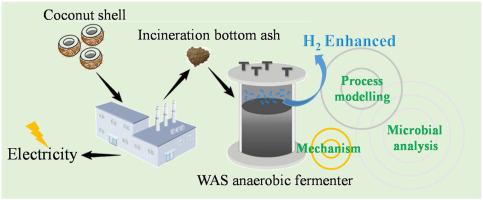Journal of Cleaner Production ( IF 9.7 ) Pub Date : 2021-09-23 , DOI: 10.1016/j.jclepro.2021.129157 Wei Wei 1 , Xingdong Shi 1 , Lan Wu 1 , Bing-Jie Ni 1

|
Previous studies reported that alkaline anaerobic fermentation was an efficient method for microbial hydrogen production from waste activated sludge (WAS) via inhibiting hydrogen-consuming microorganisms. However, the hydrogen production is still hindered by the low hydrolysis efficiency. This study proposed a new strategy to overcome this barrier by using coconut shell incineration bottom ash as mediator, which is a renewable waste and can be obtained for free from waste-to-electricity facilities. Experiment results showed that coconut shell ash (0.6, 0.9 and 1.2 g/g-Total Solids (TS)) remarkably enhanced microbial hydrogen productions from WAS in alkaline anaerobic fermentation, with the highest output being 3.2 times that without coconut shell ash mediating. Based on process modelling analysis, coconut shell ash promoted hydrogen production rate and potential of WAS by up to 7.9 and 3.0 times, and shortened the lag-phase time from 2.1 days to 0.1 day. A mechanistic study revealed that alkaline condition inhibited methonogenesis and homoacetogenesis processes for hydrogen consumption, and coconut shell ash as mediator enhanced WAS solubilization and hydrolysis that related to hydrogen generation. This was supported by microbial community analysis, which demonstrated that microbial community was changed to be favorable to hydrogen generation. This study provided an integrated waste-control paradigm by waste with more renewable energy production, achieving double benefits in sustainability and economy.
中文翻译:

深入了解椰壳焚烧底灰介导的废弃活性污泥微生物制氢
先前的研究报告称,碱性厌氧发酵是一种通过抑制耗氢微生物从废弃活性污泥 (WAS) 中微生物制氢的有效方法。然而,由于水解效率低,制氢仍然受到阻碍。这项研究提出了一种新策略,通过使用椰子壳焚烧底灰作为介质来克服这一障碍,这是一种可再生的废物,可以从垃圾发电设施中免费获得。实验结果表明,椰壳灰(0.6、0.9 和 1.2 g/g-总固体(TS))显着提高了碱性厌氧发酵中 WAS 的微生物产氢量,最高产量是没有椰壳灰介导的 3.2 倍。基于过程建模分析,椰壳灰将WAS的产氢速率和潜力提高了7.9倍和3.0倍,并将滞后期时间从2.1天缩短到0.1天。一项机理研究表明,碱性条件抑制了氢消耗的产甲烷和同型乙酸过程,而椰壳灰作为介质增强了与氢生成相关的 WAS 增溶和水解。这得到了微生物群落分析的支持,该分析表明微生物群落已改变为有利于产氢。这项研究提供了一个综合废物控制范式,废物产生更多的可再生能源,实现了可持续性和经济性的双重效益。一项机理研究表明,碱性条件抑制了氢消耗的产甲烷和同型乙酸过程,而椰壳灰作为介质增强了与氢生成相关的 WAS 增溶和水解。这得到了微生物群落分析的支持,该分析表明微生物群落已改变为有利于产氢。这项研究提供了一个综合废物控制范式,废物产生更多的可再生能源,实现了可持续性和经济性的双重效益。一项机理研究表明,碱性条件抑制了氢消耗的产甲烷和同型乙酸过程,而椰壳灰作为介质增强了与氢生成相关的 WAS 增溶和水解。这得到了微生物群落分析的支持,该分析表明微生物群落已改变为有利于产氢。这项研究提供了一个综合废物控制范式,废物产生更多的可再生能源,实现了可持续性和经济性的双重效益。这表明微生物群落已改变为有利于氢气产生。这项研究提供了一个综合废物控制范式,废物产生更多的可再生能源,实现了可持续性和经济性的双重效益。这表明微生物群落已改变为有利于氢气产生。这项研究提供了一个综合废物控制范式,废物产生更多的可再生能源,实现了可持续性和经济性的双重效益。











































 京公网安备 11010802027423号
京公网安备 11010802027423号